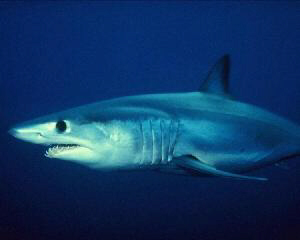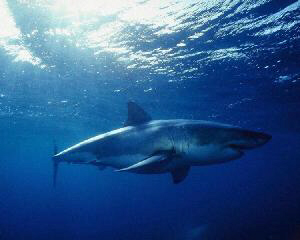|
DORSAL
FINS:
Sharks dorsal fins, as it suggests the term, are situated on the back of
the animal and generally are two, with form and different dimensions
according to the habits of life of the single kinds. In the sharks that
live to narrow contact with the fund, the fins are behind, while in
those more active, the pelagic sharks, the fins are generally found in
more advanced position. They can have triangular form, rounded off,
trapezoidal and very various dimensions, with the first dorsal almost
more great of the second. In a lot of kinds their aspect can have an
important systematic value for the recognition of the order and the
shark family. The dorsal fins are sustained by an inside cartilaginous
skeleton. It is constituted by basal cartilages, nearer to the vertebral
column and radial cartilages, connected to fibrosis rays that has to
sustain the portion more expanded of the fin. In this way the fins
acquire sturdiness and elasticity, essential characteristics for a
correct movement and equilibrium of the shark.
The dorsal fins, together with those anal, develop the function to
facilitate the maintenance of the rout and to avoid the oscillation of
the shark along his own axle. The sighting of a fin that emerges from
the surface of the water is not always tied to the presence of a shark,
there are other animals as the dolphins, the sword fishes and also the
mantas, that are usual to present themselves in surface in this way.
Then the dangerous dorsal fin that sprouts from the water, often in
partnership to great predatory sharks and source of scary histories, can
reality hide the presence of a more reassuring and beloved dolphin.
CAUDAL FIN:
The caudal fin constitutes the principal element in the shark movement:
it is in fact the move to the right and left to provoke the animal
advancement. In a lot of kinds it is clearly asymmetrical and such
irregularity of aspect is to connect to the vertebral column of the
sharks that, in the final part, folds up upward and it becomes a support
for the superior lobe of the fin. Generally this is more developed and
the terminal part has a triangular form. The inferior lobe can have
different degrees of development assuming an important role to determine
the general aspect of the tail. The inferior lobe can be small, almost
absent, as in the zebra shark and nurse shark, to allow movements in a
little distance from the fund, or very developed, reaching her same
dimensions of the superior lobe and making the tail assume a half-moon
form, as in the white shark. If a shark is observed from behind during
the swimming the difference of push can be noticed from the two lobes,
due to their different conformation. The superior lobe develops a
greater power that pushes the shark in but also downward. The situation
is balanced however by the movement of the inferior lobe, that allows to
unload big part of the propulsive energy in the center of gravity of the
animal.
The shark movement can have two different styles: the first like a eel
and the second more powerful. In the first style the caudal fin and the
whole rest of the body stir to the right and left, in rather slow and
constant way, while in the second it is only the tail to move and the
shark is characterized by a more nervous movement. These fishes
generally pass from a style to the other during their growth: like a eel
from small and more powerful when they are exemplary adults. The caudal
fin has an important systematic value for the orders and families
recognition, changing in relationship to the different shark life habits.
TEETH:
Sharks teeth are the most known part of these fishes, they constitute further a present element in the descriptions and in the images that have to strike our imagination. The teeth are similar to the placoid scales that dress the shark body; they are modified and of greater dimensions, not anchored to the cartilage of the jaws, but simply fixed in the derma by fibers of connective fabric. They are externally dressed again by an enamel that is very hard and resistant for the almost total absence of organic substance. The enamel protects a layer of dentina inside which the pulp is found, rich of blood vases. In the sharks jaws the teeth are prepared in more file, six and the last toward the inside of the mouth are generally tilted, covered by a fold of fabric and not yet completely developed. During the growth the tooth is subject to a move in ahead for the continuous formation of the gengival fabric to which is connected. In their advancement they progressively straighten, because of the simple mechanical tension, until they don't become entirely functional. After a few times the teeth of the anterior lines are destined to fall, following traumatic breakups or spontaneously and the biologist think they are singly replaced every 8-15 days, more frequently in the youngest samples. The biologist think that some kinds of sharks renew a whole line of teeth to the time.
Unlike other characters the teeth of the sharks have forms and very different dimensions, due to the alimentary habits of every kind, even if the preys are almost swallowed without mastication. They can be long and pointed, sharp, wide, of triangular form and with serrated edges: each of these solutions is proper to a particular type of prey. The teeth of the superior jaw are often different from those of the inferior jaw, to be able to make the most effective bite. Generally the superior teeth, direct to shear the preys, are greater, while those inferior, that have to furnish the maximum taking, are thinner and pointed. For the different forms and dimensions the teeth are held useful elements to the recognition of the kinds and in some cases even of the sex. Some experiments have been realized for appraising the strength engraved by the bite of a Carcharhinus: it results of around 3 tons for square centimeter and the sturdiness of the teeth has been compared to that of steel.
      
SENSE
ORGANS:
Sharks possess the
same senses of the man, more other two to us strangers, that are the
ability to perceive the electric fields and the waves of pressure
spreaded in water.
Sight: the sight of the sharks, contrarily to the popular thought,
is very developed. The pupil can tighten or to widen in base to the
light quantity, and in many sharks it is present, behind the retina, the
tapetum lucidum, a series of reflecting plates that amplify the
light and allow the sight also during the night. Under conditions of
strong illumination the tapetum lucidum is darkened, not to
dazzle the retina and to also provoke irreversible damages.
Taste: the sense of the taste in the sharks is insured from the
presence, in the mouth, but also on the surface of their skin, of
gustatory papille similar to those human. The shark therefore, can also
use this sense with the simple contact of the bodily surface.
Touch: along sharks body there are sensorial cells that are in
deep relationship with the gustatory papilles and let the shark realizes
when a physical contact happens.
Hearing: in the sharks it is present an inside ear, with the
ability to perceive above all sounds of low frequency as those sent
forth by wounded animals, and therefore potential preys for this superb
animal.
Sense of smell: the sharks nostrils, always well visible on the
inferior part of the face, are constituted by two channels to blind fund,
at the end there are cells that analyze the presence of fragrant
substances dissolved in water. The sensibilitynof the sharks is very
developed, it is thought that a shark can individualize 1 part of blood
in 100 million parts of water.
Ampullae Lorenzinii: they are of the organs that take contact
with the outside through small and numerous holes, present especially in
the region of the head, full of a gelatinous conductor substance, in
communication with nervous terminations. In this way the shark has the
ability to perceive the electric fields produced by the animals (therefore
individualize preys under the sand) and probably to recognize their
position in comparison to the magnetic earth field.
Side lines: the side lines, one for every side of the shark, are
constituted by sensorial cells that give the ability to perceive the
waves of pressure owed to the movements of the water.
PLACOID SCALES:
Sharks body is covered with placoid scales, also called like small teeth.
They have the same structure of those of greater dimensions, that are
found in the jaws. The placoid scales, besides constituting an
effectiveness protection of the shark body, reduces also the resistance
to the sea water, improving animal capacity to swin.
The teeth that are found in the jaws superior and inferior are modified
placoid scales and are very great.
GILLS:
The most greater part of the sharks have 5 gill
slits (they are 6 and 7 in the Hexanchiformes) without the presence of
the "opercolo", a protection membrane that we can found in the bony
fishes.
The respiraton happens with the passage of the water through the thin
plates of the gills; in this way the oxygen is released and transported
to the fabrics and organs while the carbonic anhydride is eliminated to
the outside.
Some kinds of sharks (above all the great raiders) have the necessity to
continually swim to make the water passing through their gills and
therefore to breathe.
They needs a great respiratory ability to sustain speed and sudden
releases and for this motive their gills are ampler and longer (for
example White shark and Mako shark) than those of the other sharks.
The bentonic sharks, that are those that support them on the fund and
generally of average-small dimensions, can remain motionless and to
breathe inhaling the water to make it passing in their gills.


CLASPERS AND PELVIC FINS:
In the male sharks the terminal part of the pelvic fins, (equal fins
that have the function to stabilize the rout of the animal) become
longer and it calcifies more and more to form the claspers (two), the
sexual organs through which the shark reproduces himself. The
reproduction is internal and appen with the introduction of a clasper
(the other one is a backup) in the cloaca of the female shark. This is a
very bloody moment, in fact the male repeatedly bites the female on the
fins and on the back to stimulate her/ and to hold her firm.
Around the 30% of the sharks has a oviparous reproduction, that is when
the female deposes outside the eggs; around 50% has a aplacental
viviparous reproduction, that is when the female produces the eggs that
develope inside her body and the small sharks go outside completely formed;
the remained 20% has a placental viviparous reproduction, that is when
the embryo is in contact with her mother through a primitive placenta.
PECTORAL FINS:
Also the pectoral fins, as all the others, have form and different
dimensions in base to the sharks habits, generally ampler and lengthen
in the bentonic sharks, that live next to the fund, smaller instead in
the great raiders that live in open sea. (smaller in proportion to the
rest of the body)
The pectoral fins have the same functions of the wings of an airplane
opposing downward the push due to the propulsion of the caudal fin.
ANAL FIN:
The anal fin, together with the dorsal ones, allows the shark to
maintain the more possible the navigation rout and to avoid excessive
oscillations along his longitudinal axle.
|
|

